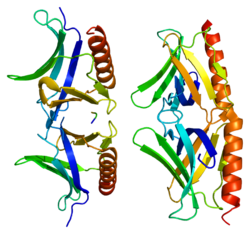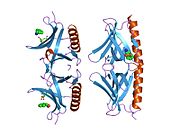| HOMER2 |
|---|
 |
| Available structures |
|---|
| PDB | Ortholog search: PDBe RCSB |
|---|
|
|
| Identifiers |
|---|
| Aliases | HOMER2, ACPD, CPD, HOMER-2, VESL-2, DFNA68, homer scaffolding protein 2, homer scaffold protein 2 |
|---|
| External IDs | OMIM: 604799; MGI: 1347354; HomoloGene: 3560; GeneCards: HOMER2; OMA:HOMER2 - orthologs |
|---|
| Gene location (Human) |
|---|
 | | Chr. | Chromosome 15 (human)[1] |
|---|
| | Band | 15q25.2 | Start | 82,836,946 bp[1] |
|---|
| End | 82,986,153 bp[1] |
|---|
|
| Gene location (Mouse) |
|---|
 | | Chr. | Chromosome 7 (mouse)[2] |
|---|
| | Band | 7|7 D3 | Start | 81,250,229 bp[2] |
|---|
| End | 81,357,275 bp[2] |
|---|
|
| RNA expression pattern |
|---|
| Bgee | | Human | Mouse (ortholog) |
|---|
| Top expressed in | - body of pancreas
- olfactory zone of nasal mucosa
- muscle of thigh
- minor salivary glands
- gastrocnemius muscle
- islet of Langerhans
- Skeletal muscle tissue of rectus abdominis
- skin of leg
- parotid gland
- skin of abdomen
|
| | Top expressed in | - lacrimal gland
- parotid gland
- transitional epithelium of urinary bladder
- lateral septal nucleus
- substantia nigra
- Region I of hippocampus proper
- crypt of lieberkuhn of small intestine
- epithelium of stomach
- olfactory epithelium
- trigeminal ganglion
|
| | More reference expression data |
|
|---|
| BioGPS |  | | More reference expression data |
|
|---|
|
| Gene ontology |
|---|
| Molecular function | - protein binding
- protein homodimerization activity
- protein domain specific binding
- synaptic receptor adaptor activity
- actin binding
- G protein-coupled glutamate receptor binding
- glutamate receptor binding
- protein heterodimerization activity
| | Cellular component | - cytoplasm
- neuronal cell body
- postsynaptic membrane
- dendrite
- synapse
- postsynaptic density
- membrane
- apical part of cell
- stereocilium tip
- cell projection
- stereocilium
- plasma membrane
- cell junction
- cytosol
- glutamatergic synapse
- neuron projection
| | Biological process | - G protein-coupled glutamate receptor signaling pathway
- chemical homeostasis within a tissue
- behavioral response to cocaine
- regulation of G protein-coupled receptor signaling pathway
- hearing
- calcium-mediated signaling using intracellular calcium source
- negative regulation of interleukin-2 production
- negative regulation of calcineurin-NFAT signaling cascade
- regulation of store-operated calcium entry
- positive regulation of signal transduction
| | Sources:Amigo / QuickGO |
|
| Orthologs |
|---|
| Species | Human | Mouse |
|---|
| Entrez | | |
|---|
| Ensembl | | |
|---|
| UniProt | | |
|---|
| RefSeq (mRNA) | |
|---|
NM_004839
NM_199330
NM_199331
NM_199332 |
| |
|---|
NM_001164086
NM_001164087
NM_011983
NM_177029 |
|
|---|
| RefSeq (protein) | | |
|---|
NP_001157558
NP_001157559
NP_036113 |
|
|---|
| Location (UCSC) | Chr 15: 82.84 – 82.99 Mb | Chr 7: 81.25 – 81.36 Mb |
|---|
| PubMed search | [3] | [4] |
|---|
|
| Wikidata |
| View/Edit Human | View/Edit Mouse |
|

 1i7a: EVH1 DOMAIN FROM MURINE HOMER 2B/VESL 2
1i7a: EVH1 DOMAIN FROM MURINE HOMER 2B/VESL 2


















